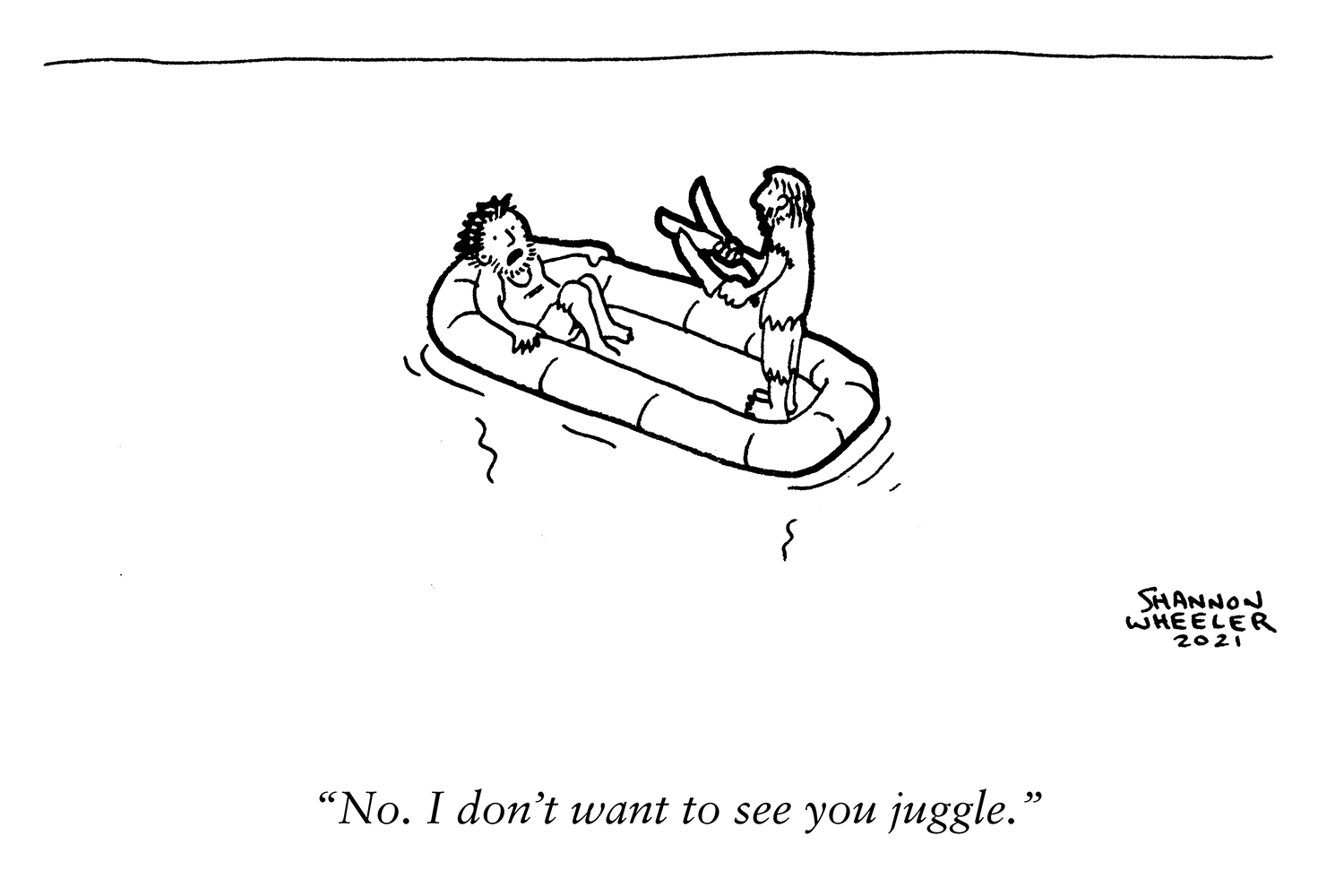I’ve decided to do something different and begin this review with a sales pitch: See Shannon Wheeler’s original ink drawings in Art Show at Portland’5 Centers for the Arts and then buy one for $150. Otherwise, if you want one, you’ll have to pay $2,000 when The New Yorker sells it through Cartoon Bank.
Cartoon Bank was founded in 1992 by Bob Mankoff, cartoonist and cartoon editor at The New Yorker from 1997 to 2017. Mankoff was editor when Wheeler began submitting his work. He submitted 10 cartoons a week for Mankoff, he says, the idea being that two would be gems.
As for subject matter, Wheeler says The New Yorker is always looking for the zeitgeist. But they also want something universal. Capturing the cultural moment and harnessing a timeless appeal seems like a tall order for a single-panel cartoon. But Wheeler says he looks at these cartoons as puzzles, layered pieces to be deconstructed and then solved.
All the cartoons in Art Show, both finished ones and roughs, were submitted to The New Yorker. They represent a return after taking a year off from submitting, during which time he co-created, along with Oregonian columnist Steve Duin, The Mueller Report: A Graphic Novel.
Wheeler wanted to read the report, he says, because everyone had an opinion on it but few were informed in terms of actually having read it.
Originally from Berkeley, California, Wheeler has been living in Portland for 25 years. So, how does a transplanted Californian turned Oregonian become a New Yorker cartoonist?
Well, it took a lot of work.
He’d already made a name for himself with his underground comic “Too Much Coffee Man, ” which ran in Eugene Weekly in the past, by the time he met Matt Diffee, a New Yorker cartoonist who was in Portland for a lecture. Wheeler asked for advice, and Diffee offered and delivered it for eight months, commenting on cartoons and providing feedback on work that Wheeler sent to New York.
One piece of Diffee’s advice that stands out to me: The New Yorker doesn’t like puns.
Puns aren’t storytelling, Wheeler explains.
He now thinks of each cartoon as a short story. This minimalistic approach to storytelling is affecting his artistic style, too. He is cutting back using value and gray tones, working more with just the simplicity of the line.
The one-panel cartoon is a snapshot, he says, but it’s also part of a larger story. Take his cartoon of an old man and a cat, for example. The man has a long beard and the cat is facing a chair. The ground is fluffy, and we get the idea it’s made of clouds.
“Don’t even think about it,” the caption reads.
The reader has to figure out the man is God, and then that God has a past relationship with the cat. How else would he know what the cat was thinking of doing? Will the cat jump up on the chair, like it probably has before, despite the warning from God? A future exists for both these characters, even if we don’t know what it is.
Another of Wheeler’s cartoons in the exhibit strikes closer to home. It pictures an artist working on a painting. A woman stands beside him, looking at his work. She is the one speaking.
The caption reads, “I think that’s worth 900 words.”
The whole idea of assigning worth to art — whether by word count or monetary value — can be quite random. Experts are still trying to work out the formula for how art accumulates value. And at Eugene Weekly, like other print publications, word count can be tied to ad revenue, the presence of a pandemic (which relates back to ad revenue) or to whether breaking stories might need space.
“How many words do you think your art is worth?” I ask Wheeler. It’s sort of a tongue in cheek question, but I’m curious. He mulls it over and says, “A thousand.”
I have to apologize, then, because I didn’t get that many words for this story. On the other hand, one of Wheeler’s cartoons will be published along with it, I hope. And what is that saying about a picture’s worth having something to do with a thousand words?
Art Show is on display at least until Dec. 30. Admission to Portland’5 Centers for the Arts is free but proof of COVID vaccination or a negative test result is required. For more information: Portland5.com/visitor-info. For information about buying artworks from the show, contact jeanniebaker@portland5.com.



